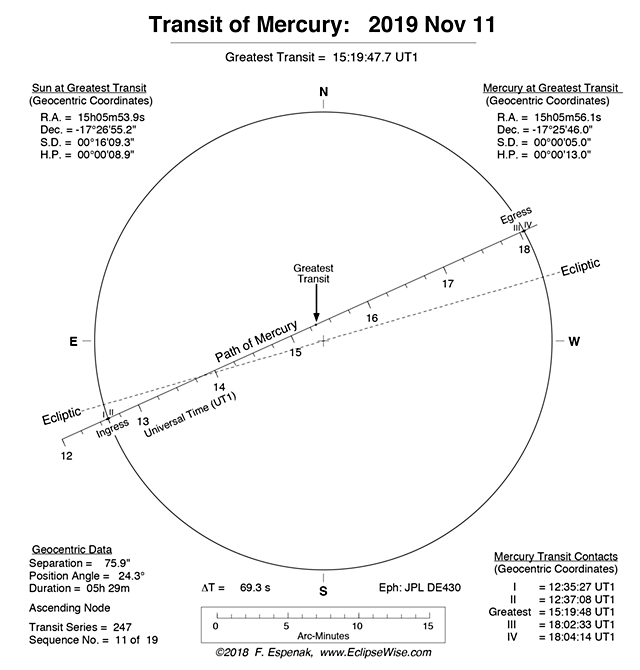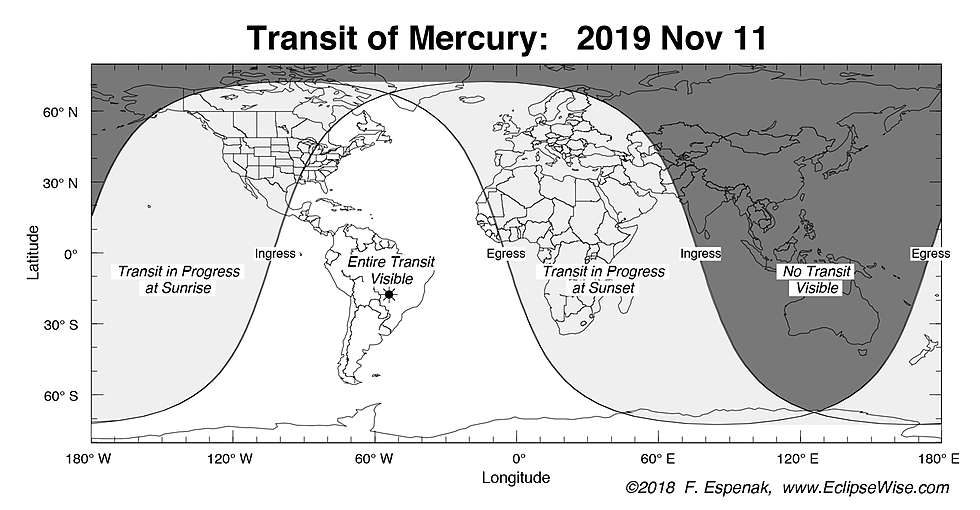2019 Transit of Mercury
By Fred Espenak
Published in Observer's Handbook 2019, Royal Astronomical Society of Canada
On Monday, 2019 November 11, Mercury will transit the Sun for the first time since 2016. The transit or passage of a planet across the face of the Sun is a relatively rare occurrence. As seen from Earth, only transits of Mercury and Venus are possible. There are approximately 13 transits of Mercury each century. In comparison, transits of Venus occur in pairs with more than a century separating each pair.
The principal events occurring during a transit are conveniently characterized by contacts, analogous to the contacts of an annular solar eclipse. The transit begins with Contact I, which is the instant when the planet's disk is externally tangent to the Sun. Shortly after Contact I, the planet can be seen as a small notch along the solar limb. The entire disk of the planet is first seen at Contact II when the planet is internally tangent to the Sun. During the next several hours, the silhouetted planet slowly traverses the brilliant solar disk. At Contact III, the planet reaches the opposite limb and once again is internally tangent to the Sun. Finally, the transit ends at Contact IV when the planet's limb is externally tangent to the Sun. Contacts I and II define the phase called ingress while Contacts III and IV are known as egress. Position angles for Mercury at each contact are measured counterclockwise from the north point on the Sun's disk.
| Table 1: Geocentric Phases of the 2019 Transit of Mercury | ||
| Event | Universal Time | Position Angle |
| Contact I | 12:35:27 | 109.8° |
| Contact II | 12:37:08 | 109.8° |
| Greatest Transit | 15:19:48 | 24.3° |
| Contact III | 18:02:33 | 298.8° |
| Contact IV | 18:04:14 | 298.7° |
Table 1 gives the times of major events during the 2019 transit in Universal Time (UT1). Greatest transit is the instant when Mercury passes closest to the Sun's center (i.e., minimum separation). At this time, the geocentric angular distance between the centers of Mercury and the Sun will be 75.9 arc-seconds. The position angle is the direction of Mercury with respect to the center of the Sun's disk as measured counterclockwise from the celestial north point on the Sun.

Path of Mercury Across the Sun During the Transit of 2019 Nov 11
(click for larger diagram)
Figure 1 above shows the path of Mercury across the Sun's disk and the scale gives the Universal Time of Mercury's position at any instant during the transit. The contact times are listed along with the equatorial coordinates of the Sun and Mercury at greatest transit. Since the contact times are geocentric they are only correct for an observer stationed at Earth's center. The contact times for any given location may differ from the geocentric times by up to 2 minutes. This is due to the effect of parallax since Mercury's 10 arc-second diameter disk may be shifted up to nearly 13 arc-seconds from its geocentric coordinates depending on the observer's exact geographic position.

Global Visibility of the Transit of Mercury on 2019 Nov 11
(click for larger diagram)
The transit will be widely visible from most of Earth including the Americas, the Atlantic and Pacific Oceans, New Zealand, Europe, Africa and western Asia, as shown in Figure 2 above. None of the transit will be visible from central and eastern Asia, Japan, Indonesia, and Australia.
The transit begins before sunrise for observers in western North America. The transit ends after sunset for Europe, Africa, western Asia, and the Middle East. Regions where the entire transit is visible include eastern North America, Central and South America, and the Atlantic Ocean. Tables 2 and 3 list predicted contact times and the corresponding altitude of the Sun for a number of cities in Canada and the USA, respectively. Contact times for additional cities in Canada and the USA as well as other nations can be found online at:
Table 2 lists predicted contact times and the corresponding altitude of the Sun for a number of cities in Canada:
Table 3 lists predicted contact times and the corresponding altitude of the Sun for a number of cities in the United States:
Observing the Transit
Since Mercury is only 1/194 of the Sun's apparent diameter, a telescope with a magnification of 50x or more is recommended to watch this event. The telescope must be suitably equipped with adequate filtration to ensure safe solar viewing. The visual and photographic requirements for the transit are identical to those for observing sunspots and partial solar eclipses. Amateurs can make a useful contribution by timing the four contacts at ingress and egress. Observing techniques and timing equipment are similar to those used for lunar occultations. Since poor seeing often increases the uncertainty in contact timings, an estimate of the possible error associated with each time should be included. Transit timings and geographic coordinates of the observing site (measured from GPS) should be sent to Dr. John E. Westfall ([email protected]), ALPO Transit Section, 5061 Carbondale Way, Antioch, CA 94531.
White light observations of Contacts I and IV include a small bias since Mercury is only visible after Contact I and before Contact IV. However, if Hydrogen-alpha filtration is available, the planet may be visible against either prominences or the chromosphere before and after Contacts I and IV respectively.
Observations of Contacts II and III also require amplification. They're actually the instants when the planet appears internally tangent to the Sun. However, just after the real Contact II, the so-called black drop effect is seen. At that time, the transiting planet seems to be attached to the Sun's limb by a thin column or thread. When the thread breaks and the planet is completely surrounded by sunlight, this was sometimes called Contact II, but really is delayed by some seconds, up to a minute. Contact III occurs in exactly the reverse order. Atmospheric seeing often makes it difficult to measure contact timings with a precision better than several tens of seconds.
Recurrence of Transits
During the present era, transits of Mercury fall within several days of May 8 and November 10. Since Mercury's orbit is inclined seven degrees to Earth's, it intersects the ecliptic at two points or nodes, which cross the Sun each year on those dates. If Mercury passes through inferior conjunction at that time, a transit will occur. During November transits, Mercury is near perihelion and exhibits an apparent disk only 10 arc-seconds in diameter. By comparison, the planet is near aphelion during May transits and appears 12 arc-seconds across. However, the probability of a May transit is smaller by a factor of almost two. Mercury's slower orbital motion at aphelion makes it less likely to cross the node during the critical period. November transits recur at intervals of 7, 13, or 33 years while May transits recur only over the latter two intervals. Table 4 lists all transits of Mercury from 2001 through 2100.
| Table 4: Transits of Mercury: 2001-2100 | ||
| Date | Universal Time | Separation |
| 2003 May 07 | 07:52 | 708" |
| 2006 Nov 08 | 21:41 | 423" |
| 2016 May 09 | 14:57 | 319" |
| 2019 Nov 11 | 15:20 | 76" |
| 2032 Nov 13 | 08:54 | 572" |
| 2039 Nov 07 | 08:46 | 822" |
| 2049 May 07 | 14:24 | 512" |
| 2052 Nov 09 | 02:30 | 319" |
| 2062 May 10 | 21:37 | 521" |
| 2065 Nov 11 | 20:07 | 181" |
| 2078 Nov 14 | 13:42 | 674" |
| 2085 Nov 07 | 13:36 | 718" |
| 2095 May 08 | 21:08 | 310" |
| 2098 Nov 10 | 07:18 | 215" |
Mercury transits separated by the interval of 46 years occur on nearly the same calendar date (within 1-2 days depending on the number of intervening leap years) and same orbital node, and the planet has a similar path across the Sun. This makes the 46-year period an analog to the Saros period for solar eclipses. It's a natural period in which to organize Mercury transits into series. The transit of 2019 is a member of series 247. It is the 11th of 19 transits in the series running from the years 1559 to 2387. Transit series are numbered in the order in which each reaches its midpoint in a 100,000-year catalog developed by Aldo Vitagliano.
Edmund Halley first realized that transits could be used to measure the Sun's distance, thereby establishing the absolute scale of the solar system from Kepler's third law. Unfortunately, his method is somewhat impractical since contact timings of the required accuracy are difficult to make. Nevertheless, the 1761 and 1769 expeditions to observe the transits of Venus gave astronomers their first good value for the Sun's distance.
Because Venus's orbit is considerably larger than Mercury's, its period is also longer, making transits of Venus much more rare. Indeed, only eight such events have occurred since the invention of the telescope (1631, 1639, 1761, 1769, 1874, 1882, 2004 and 2012). During the current era, transits of Venus are only possible in early December and early June when Venus's orbital nodes pass across the Sun. Venus transits show a clear pattern of recurrence at intervals of 8, 121.5, 8 and 105.5 years. The next two transits of Venus occur over a century from now on 2117 Dec 11 and 2125 Dec 08.
Catalogs of Transits
EclipseWise.com features two catalogs listing dates and details for all transits of Mercury (1600 to 2300) and Venus (3000 BCE to 3000 CE). The transit catalogs were generated using the JPL DE406 planetary ephemeris. Both catalogs can be accessed from the transit page at:
www.EclipseWise.com/transit/transit.html
To determine whether a transit is visible from a specific geographic location, it is simply a matter of calculating the Sun's altitude and azimuth during each phase of the transit. As an aid to historical research, the transit catalogs have also been ported into several Microsoft Excel spreadsheet files which perform the these calculations automatically. Upon entering the desired latitude and longitude, each Excel file calculates the altitude of the Sun at that location for every transit in the file and at each of the four contacts. To simplify the spreadsheet calculations the Sun's geocentric coordinates at greatest transit are used. This results in the accuracy in the Sun's altitude to within one degree. The Excel files can be accessed at:
www.EclipseWise.com/transit/catalog/visible.html
Acknowledgments
The 2019 Transit predictions were generated on an Macintosh G4 computer using algorithms developed from Meeus [1989] and the Explanatory Supplement [1974]. Ephemerides for the Sun and Mercury were generated from JPL DE406. All calculations, diagrams, tables and opinions presented in this paper are those of the author and he assumes full responsibility for their accuracy.
References
Explanatory Supplement to the Astronomical Ephemeris and the American Ephemeris and Nautical Almanac, 1974, Her Majesty's Nautical Almanac Office, London.
Meeus, J., 1989, Transits, Willmann-Bell, Inc., Richmond, VA.
